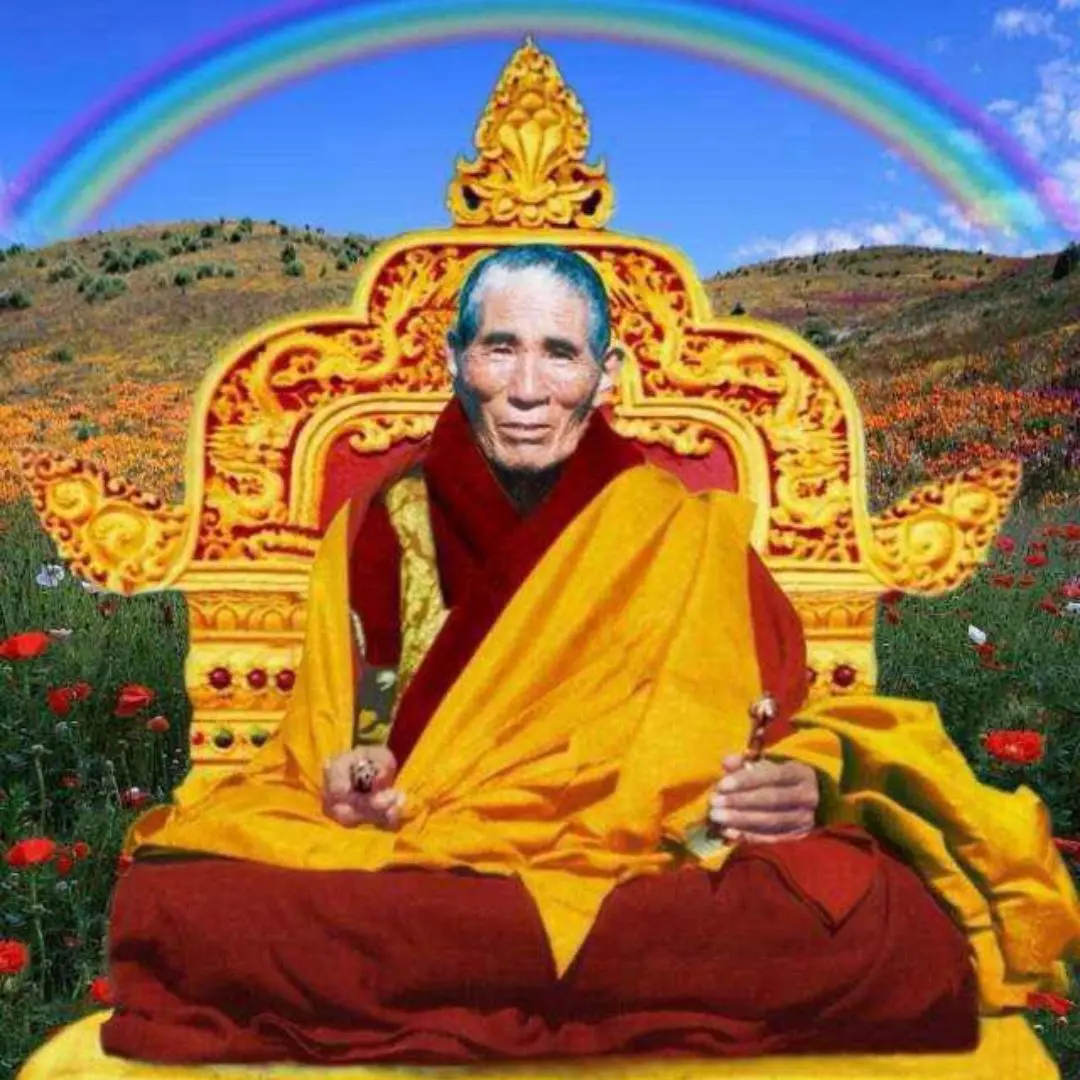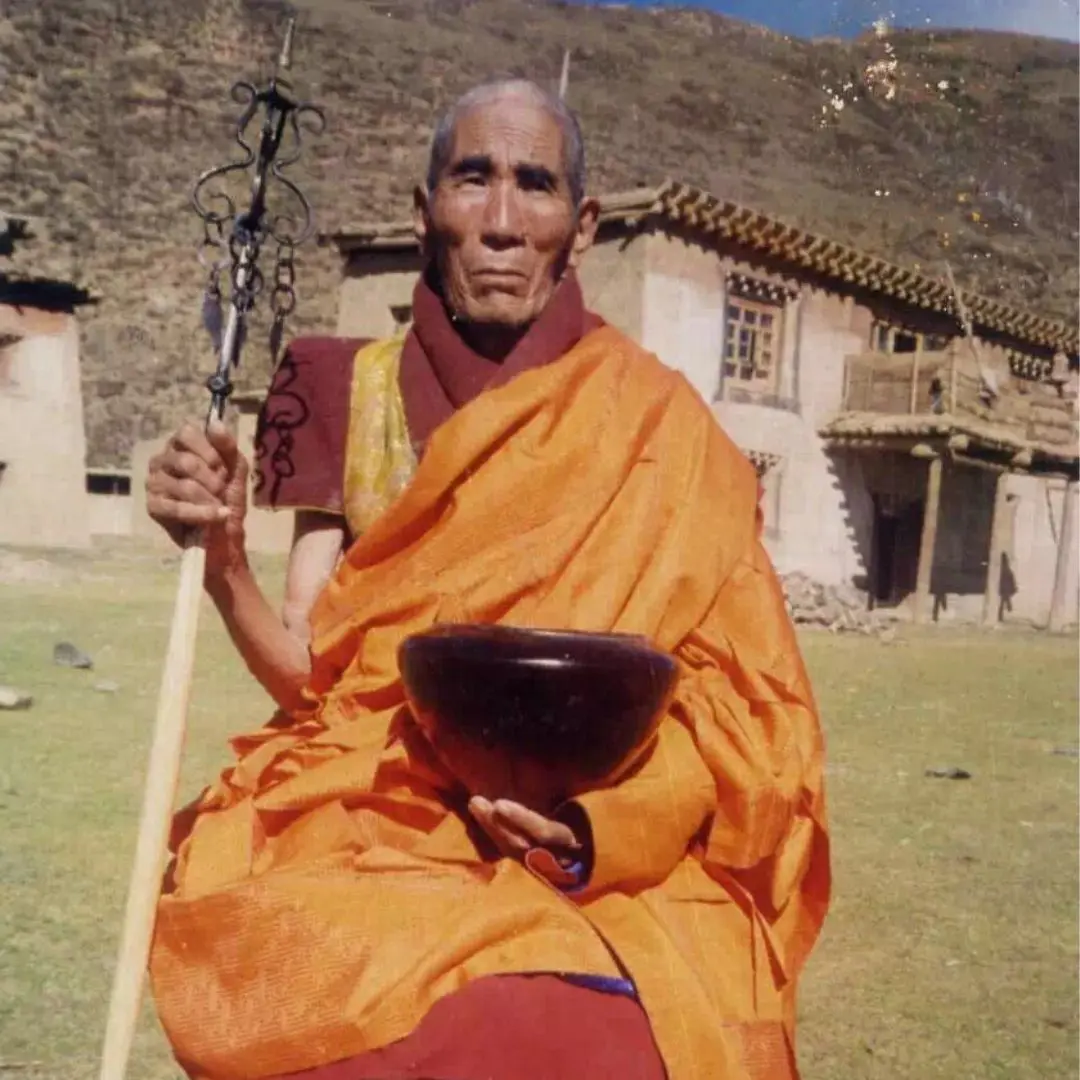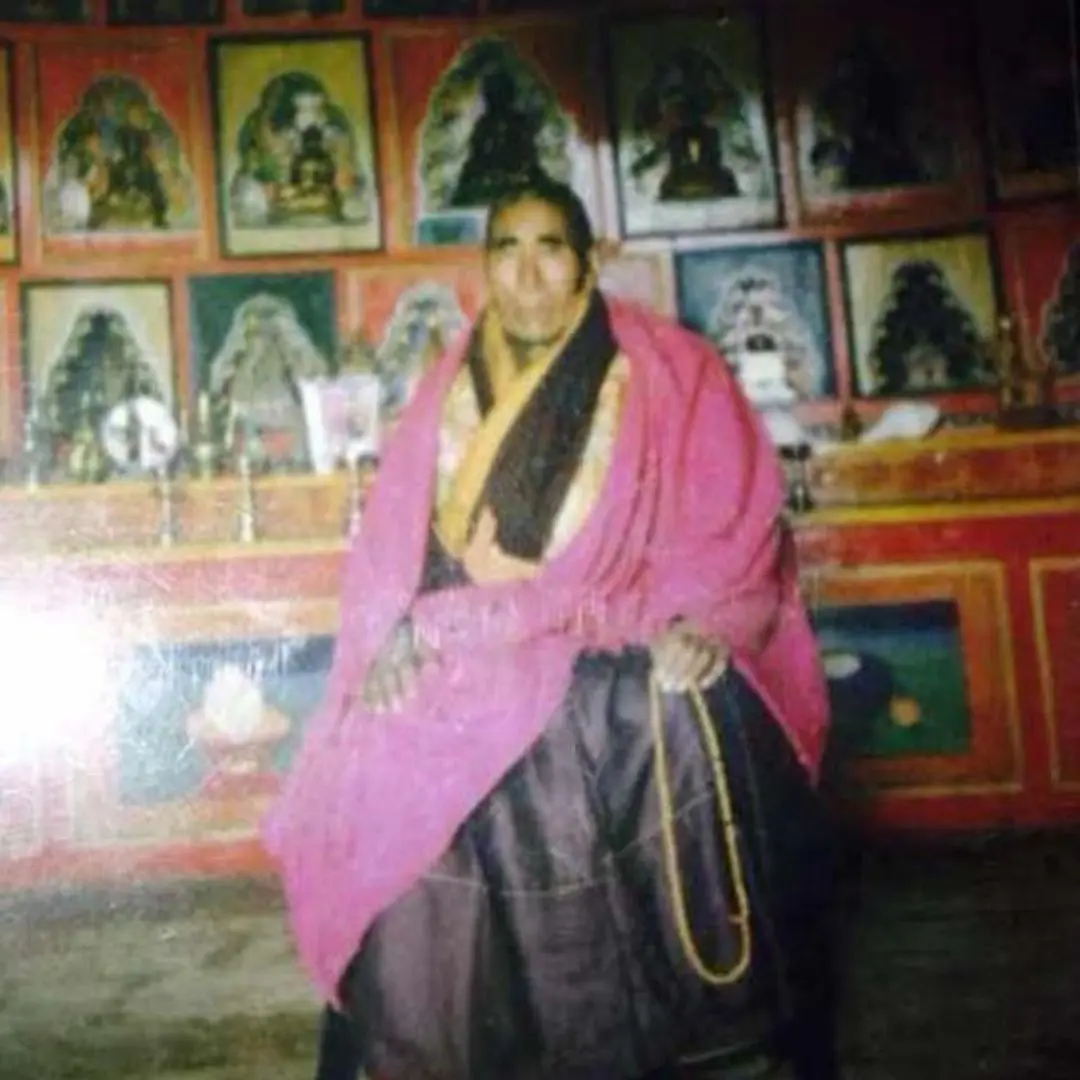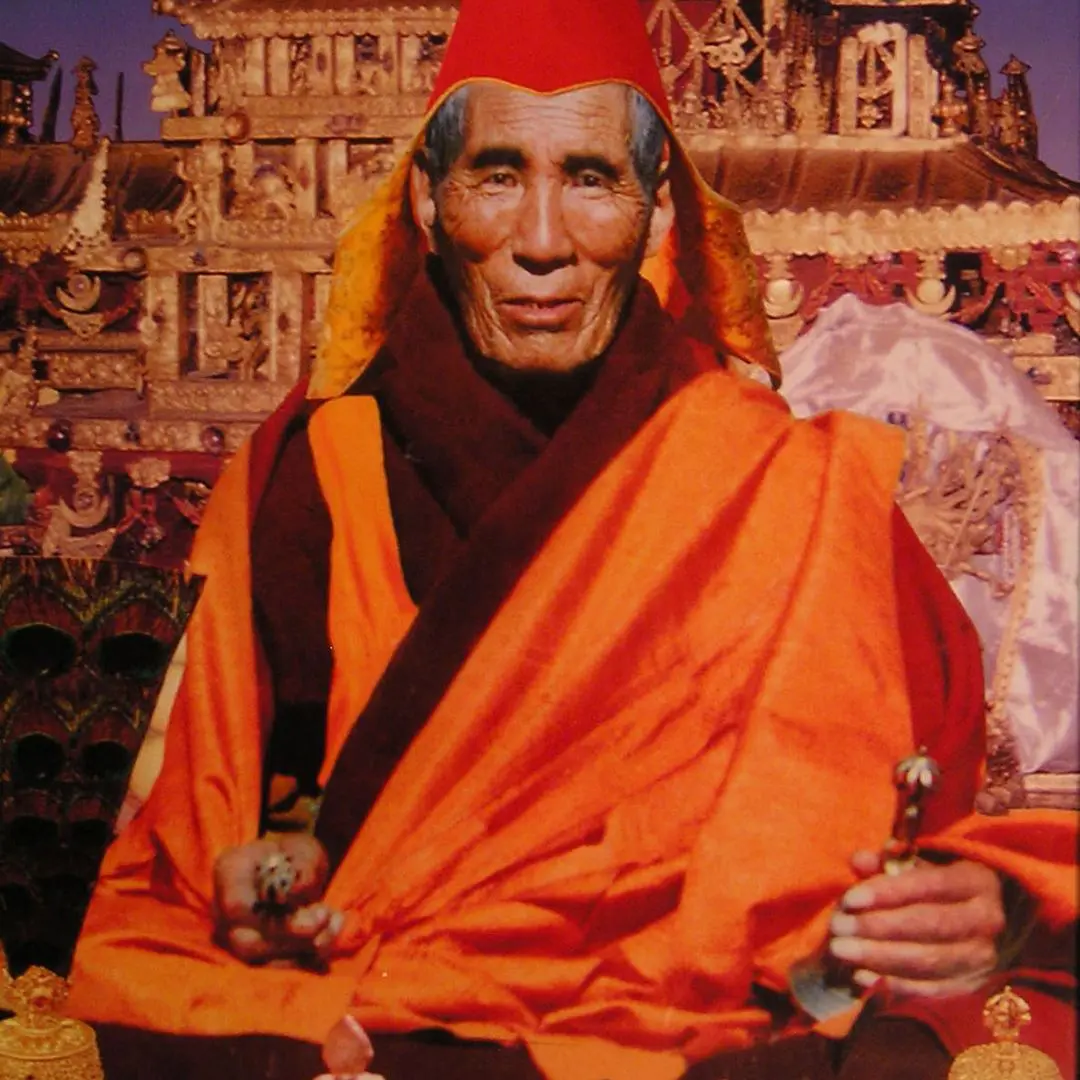Lama Lobsang Trinley – Great Mahasiddha of Tashi Chöthang
Lama Ngawang Lobsang Trinley, also known affectionately as Lama Lutrin or Kyabje Lama, was a highly realized Tibetan master born in 1917 in Mimdi village, nestled within the Zuka Valley of the Kham region in southeastern Tibet. His family line was known as Achak Dri, and he was the beloved son of Kalsang Kyap and Yakshieza Tashikyi. From the very beginning, signs of his extraordinary nature were evident. The day after his birth, the great Zamngu Lama proclaimed with astonishment, “Longroma’s family has just had a child; this child is an extraordinary and highly realised being.” (‘Longroma’ was a nickname for his father, meaning “Short-Tempered.”) This prophetic declaration would prove to be true many times over throughout Lama Lobsang Trinley’s remarkable life.
As a young child, Lama Lobsang Trinley loved to imitate monastic life, pretending to meditate, teach, and debate. However, in his early teenage years, his mischievous nature surfaced. At the age of ten, he often challenged others, both physically and mentally, leading his family to believe he would grow up to become a formidable warrior and protector of his village. This thought filled his father with great pride, and few could have imagined that he would instead take the path of a monk.
At the age of fourteen, his mind turned again, with powerful and unshakable enthusiasm, toward a monastic life. Despite concerns from his family that he might disrupt the monastery with his strong-willed nature, Lama Lobsang Trinley persisted and eventually entered Chayul Monastery. There, he studied under the great master Ngawang Tenpa Rabgyé. Under his teacher’s close guidance, he immersed himself completely in the profound path of the Kalachakra Tantra. He received the teachings of five common and two uncommon preliminary practices and the Kalachakra empowerment. His devotion was so fierce and pure that within just two weeks of intensive and undistracted practice, he manifested the ten signs of Kalachakra realization — a rare and extraordinary attainment.
Ngawang Tenpa Rabgyé openly praised him, telling others that one of his students was an emanation of an Indian Mahasiddha, a statement widely believed to refer to Lobsang Trinley. Although he was profoundly realized internally as a tantric practitioner, externally he maintained strict Vinaya discipline, carefully upholding even the smallest rules of monastic conduct, such as abstaining from afternoon meals. His outer conduct reflected humility and impeccable moral discipline, concealing the depth of his inner accomplishments.
In his twenties, faced with the hardship of his family’s declining financial situation, Lama Lobsang Trinley made the difficult decision to pause his formal studies to travel and seek support for his family. Yet, even during these challenging times, he remained steadfast in his spiritual discipline and devotion to Dharma practice, never wavering from the path he had so diligently chosen.
Great Mahasiddha
Lama Lobsang Trinely cured himself and others of leprosy. Those who suffer from leprosy. He entered in retreat without eyebrows and returned many years later with bushy lush overflowing eyebrows.
Cured Leprosy in 5 Year Retreat
Later, in his thirties, Lama Lobsang Trinley encountered a life-altering trial when he contracted leprosy. Rather than seek conventional cures, he chose the path of deep retreat, isolating himself for five years in intensive Vajrapani practice. The retreat was marked by miraculous phenomena: his sickness manifested visibly as thousands of worms that emerged from his body, dissolving and transforming into tormas—ritual offerings—which exuded an extraordinary fragrance. Miraculously, he emerged from retreat completely healed without having studied formal Tibetan medicine, yet endowed with the spontaneous ability to heal others through spiritual and medicinal means.
The tormas from his retreat, infused with his realized blessings, remained perfectly preserved, radiating a sweet ambrosial scent, and pieces of them are still revered and used today to heal illnesses. Lama Lobsang Trinley spent the remainder of his life healing thousands of people, especially those afflicted by leprosy, and mastering Tibetan astrology and medicine. His compassion was boundless, and his abilities so profound that people from far and wide sought his blessings not only for healing but also for spiritual guidance.
Throughout his life, he worked tirelessly to preserve and rebuild Mahayana and Vajrayana Buddhism in its purest form. Following the devastation of regional conflicts and the restrictions during the Chinese occupation, Lama Lobsang Trinley took a leading role in reviving the sacred traditions. He re-established Tashi Chöthang Monastery and trained hundreds of monks, many of whom became renowned khenpos and teachers in both the Jonang and other traditions. Despite offers from major universities, monasteries, and even the Chinese government in Beijing to teach, he humbly declined, choosing instead to share the precious teachings of the Kalachakra Six Yogas only with genuinely devoted practitioners.
Regarded by many as a living Bodhisattva, Lama Lobsang Trinley was recognized in different ways by his pure disciples: some perceived him as Medicine Buddha, others as Avalokiteshvara or Vajrapani. His realization was evident not only in his miraculous healings but also in the transformative impact he had on the lives of those around him. Among his most precious heart-sons was Khentrul Rinpoche Jamphel Lodrö, whom Lama Lobsang Trinley recognized as the reincarnation of the great Kalachakra adept Ngawang Chözin Gyatso. To signify this recognition, he bestowed upon Rinpoche his own treasured pandita hat, a symbol of supreme scholarly accomplishment.
He gave extensive Buddhist teachings to hundreds of monks; many of them became great khenpos in the Jonang and other traditions as well. He renounced all worldly concerns and didn’t seek any fame or social standing. He was invited to teach by many famous monasteries and universities, including the Chinese Government in Beijing but he refused all these invitations. He only taught the Kalachakra Six Yogas to genuine practitioners. He appointed Lama Ngangthon to be the Kalachakra master at Chothang Monastery; he also selected Khenpo Nangwaphal to teach monks at Chothang Monastery to become Buddhist scholars.
He guided thousands of peoples’ way of life using his special abilities and Tibetan astrological methods; his predictions always became true. Using his special abilities, he cured thousands of people from many provinces of their many illnesses. Many people sought his treatment even though they were not ill because they believed that his treatment was a great blessing and would help them to have a fortunate rebirth. People who had been suffering for many years from incurable illnesses would be cured miraculously through what appeared to be very simple treatments.
His Compassionate Display of Siddhis
Lobsang Trinley performed many of these miracles. Somehow over time, people from many regions considered him ‘Kyabje Lama’; ‘Kyab’ means rescuer or someone you seek refuge from, ‘Je’ means a great or extraordinary person. Some fortunate good practitioners and lamas could perceive him in an enlightened form. Taklha Norbu (a great physician), Dodrup Lama Jigme Osal and Lama Tamchu perceived him to be the Medicine Buddha; some pure students perceived him as Vajrapani. Golok Lama Tsalden perceived him as Chokle Namgyal. Darthong Tulku Longpo perceived him to be Amitabba Buddha.
The great Lama Lodro Drakba told his attendants Lama Yonten Zangpo, ‘Last night I dreamt of a Golden Vajra illuminated from the west. Today, an emanation of Vajrapani will come to us.’ He asked his attendant to tidy the room and to prepare a nice meal. Later that day, Kyabje Lama came to visit Lama Lodro Drakba; they had a deep and enjoyable Dharma conversation. A very famous geshe, Allak Muge Sampten, dreamt of the great Jamyang Shetpa. The day after his dream, he met Kyabje Lama. He strongly believed that Kyabje Lama was Jamyang Shetpa. Throughout his life, Lama Lobsang Trinley worked tirelessly to rebuild and preserve the purity of Mahayana and Vajrayana Buddhism. He re-established Tashi Chöthang Monastery, which had been severely damaged during regional conflicts, and taught countless monks who would later become prominent khenpos across Tibet. Despite invitations from major monasteries, universities, and even the Chinese government to teach, he remained humble and selective, offering the profound Six Yogas of Kalachakra only to genuine practitioners.
Highly respected among scholars, monks, and laypeople alike, Lama Lobsang Trinley performed many miraculous healings and spiritual feats. His realization was perceived by pure disciples in various sacred forms—such as Medicine Buddha, Avalokiteshvara, and Vajrapani. His disciple Khentrul Rinpoche Jamphal Lodro experienced vivid dreams confirming Lama Lobsang’s enlightened nature, witnessing him in various divine forms, including a Shambhala Rigden King and a shravaka monk. Lama Lobsang Trinley recognized Khentrul Rinpoche as the reincarnation of the great Kalachakra adept Ngawang Chözin Gyatso and bestowed upon him his own precious pandita hat, a symbol of the highest scholarly accomplishment.
One of Kaybje Lama’s students, Purtsa Trinley had a tragic death and Lama performed the Powa prayer. That night Purtsa Trinley appeared in Lama’s dreamt in a brighter and pleasing form. Lama asked him if he had a good rebirth. Purtsa Trinley replied in the dream, ‘Yes, thanks to your power and compassion.’ When some of Kyabje Lama’s students met Kongthang Tenbe Dorme, and told him who their teacher was, Kongthang Tenbe Dorme exclaimed what an extraordinary Lama they had. He wrote a supplication to offer to Kyabje Lama.
There was an extremely powerful and an infamous demon called Segyal who terrified everyone in the region and caused many lamas to die. Segyal once appeared to Kyabje Lama as a young monk. Instead of trying to harm the Lama as he would normally do, Segyal requested the Lama to give him the Kalachakra empowerment. The Lama refused to give him the empowerment but instead gave him a brief Kalachakra teaching and recitation. Segyal appeared to be at peace and the Lama felt that he had been of some benefit to him. One monk by the name of Tsongden (from Jhamda monastery) had lost his voice and no one could cure this illness. After Lobsang Trinley burnt incense in a few places on his neck, the monk found that he could speak again. One of his students often suffered from extreme pains in the stomach. Doctors could not find a cure for this complaint. Lama ate some tsampa dough and gave the rest to his student. After eating the tsampa, the student never suffered those pains again. There was a lame man who told the lama that he was unable to harvest his barley because of his leg. After the lama burnt ‘moksa’ on the man’s leg, the man was permanently cured. On one occasion one of his students, Drolma Sung, brought a deaf and dumb girl who wished to die. Lama performed the Powa prayer; this is a prayer to transfer consciousness to a better rebirth. Lama said that if she died within a few days, she would have a good rebirth. The girl died the next day.

Entered Parinirvana at Saka Dawa Amidst Miraculous Signs
In 1999, although perfectly healthy, Lama Lobsang Trinley announced that his time to pass had come. He instructed his students not to pray for his continued life, explaining that the interdependent connection between his mind and body had completed its purpose. On the auspicious day of Saka Dawa, he peacefully entered Parinirvana in full awareness, seated in meditation posture, after blessing his students with final teachings.
Just before his death, the Lama asked for the three parts of the monks’ robes to be brought to him. These were the shamthap, laku and namgyal. The laku and namgyal were usually only worn for ceremonial purposes. After having put the robes on, Kyabje Lama sat in the half-vajra position on the floor, his hands in the mudra of Amitabha Buddha and composed himself. He then turned his face to each student, one by one, and stared straight at them for a few seconds. After looking at them all, he announced, ‘I am going to Sukhavati and any person who is devoted to me or to Amitabha Buddha will be able to be born there.’ He took one small in-breath and then one large in-breath. And then he passed away. (When ordinary people die, the last breath is an out-breath and there is no inhalation. However, when extraordinary practitioners die, the opposite happens.)
Five days later when monks were allowed to go to the Lama’s room; his body was still sitting in the meditation posture, in the state of Buddha mind. After thirteen days, his body showed no signs of decay and radiated a profound fragrance and luminosity.
Lama’s funeral was attended by at least 1400 monks and many thousands of lay people. Never before had so many people gathered for a funeral ceremony in this region; such was the great popularity of Lama Kyabje.
Lama’s body was placed inside a stupa which had been specially built for the funeral. When the fire had nearly finished burning, and everything had turned to ash, an object suddenly flew out of it and landed in front of Tsangwa Kumdrang. It was Lama’s eyeball, tongue and heart all compacted together and perfectly preserved, with no burn-marks. It is well known in Tibet that some highly realised masters leave these three parts of the body, symbolising their blessings of body, speech and mind as relics for their followers.
When the stupa was opened three weeks after the funeral, the walls of the stupa had naturally-formed images of many deities such as: Vajrapani, Manjushri, Avalokiteshvara, Kalachakra and Yamantaka. The walls also contained many symbols such as: vajra, bell, damaru, stupa and many mantras in Sanskrit and Tibetan such as Hung Bhazra Phat, Om Amitabha Sri, Om Ha Kya Ma La Wa Ra Yang.
Not far from the monastery is a river that has many tributaries that often overflow and make their way closer and closer to the temple. People often worried that they would come too close and flood the monastery. When the stupa was built, the tributaries flowed back into the river and they never flowed back toward the monastery again.
Fulfilling his earlier promise, Lama Lobsang Trinley sent all his sacred relics and statues to the Potala Palace in Lhasa, ensuring that no attachment would arise among his monastic community. His final act inspired both great reverence and deep reflection among his followers. Lama Lobsang Trinley is remembered today as a true Mahasiddha, a master of the Kalachakra path, and a living embodiment of Vajrayana realization whose blessings continue to benefit countless beings.
Amitabha Pureland and Additional Practices
Lama Lobsang Trinley took incredible care of the people of his region. In that area and time many were illiterate and did not know many Buddhist practices but were filled with incredible faith and devotion. While Lama Lobsang Trinley taught the monks the highest Yoga Tantra of the 6 Vajra Yogas, he taught the householders the powerful practices of Amitabha pureland. Those living in their homes would not have the time or capacity to learn all of the Kalachakra path but could recite the mantra of Amitabha. Since the number one factor in going to Amitabha pureland is zero doubt and 100% faith this was the most beneficial practice of the people. In a display of incredible compassion and inspiring faith of generations, Lama Lobsang Trinley predicted his own death and went to Amitabha’s pureland Sukhavati. Before passing away he bestowed his precious text of Amitabha on Khentrul Rinpoche and asked him to give this empowerment in the world. In 2024, with indications that it was the right time, Khentrul Rinpoche has started to transmit this practice. The most revered Thangka painter at Tashi Chöthang spent a year painting all of the items included in the description of Amitbaha’s pureland that was in Lama Lutrin’s texts.
༄༅།།རྒྱལ་ཀུན་འདུས་པའི་རྩ་ལག་ཆེན་པོ་རྣམས་ལ་གསོལ་འདེབས་ཐུན་མོང་མ་ཡིན་པ་དང་བྱང་ཤམྦྷ་ལའི་སྨོན་ལམ་གདམ་ངག་མང་འདུས་བྱིན་ཅན་བཞུགས་སོ།།
The Divine Shower of Blessings
A Supplication to the Exalted Master Lobsang Trinlé
A collection of Khentrul Rinpoche’s unrestricted prayers are available in the Dzokden Learning Center.





